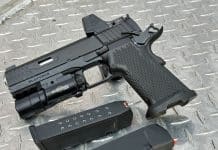[dcs_img_right
framed=”black” w=”250″ h=”80″]
http://gunsandtactics.wpengine.com/wp-content/uploads/2012/05/rheinmetall_logo.jpg
[/dcs_img_right]
Nobody builds armored vehicles like the Germans. And while advanced sensors, battlefield network solutions, and ballistic protection are all extremely important in combat, nothing says sexy like tons and tons of angled metal riding atop a pair of tracks and mounting weapon systems that are very large, very lethal, or both. So let’s have a look at German defense giant Rheinmetall, which will be exhibiting at this year’s Eurosatory defense exposition in Paris June 11-15.
Rheinmetall offers a long list of defense products, from vehicles to air defense systems to ammunition to mine clearing, nuclear-biological-chemical (NBC) reconnaissance, and cargo handling. But here and in Part 2 we’re going to focus on some of its sexier offerings, looking at four of its tracked vehicle families.
In the “light but lethal” category is the Wiesel family. The Wiesel was designed specifically to be light enough to accompany airmobile forces, and will actually fit inside a CH-53 transport helicopter. (More traditionally, these vehicles can be sling-loaded as well, or carried aboard a fixed-wing transport.)
For the original Wiesel 1 family—which entered service in 1982 and ended production in 1993—“light” meant about 2.8 tons. This version came in armored reconnaissance, fire support, anti-tank, anti-tank resupply, battlefield surveillance radar, recovery, ambulance, and air defense variants. The armored reconnaissance and one version of the fire support Wiesel mounted a 20mm cannon; a later version of the fire support vehicle used a 25mm cannon. The anti-tank variants used HOT or TOW missiles.
The Wiesel 2 family entered service in 2001. It is easily distinguished from the Wiesel 1 by the presence of four instead of three road wheels, owing to a length of 4.2 meters versus 3.26 meters for the older version. The Wiesel 2 added an NBC protection system for the crew and boasts a 109hp engine compared to the 86hp of its lighter predecessor.
The Wiesel 2 is available in several named variants, including the Argus armored reconnaissance vehicle, the Pionier combat engineer reconnaissance vehicle, the Primus reconnaissance and fire control vehicle, and the Ozelot air defense version. (There are actually three Wiesel 2 air defense variants: a command and control vehicle, a radar vehicle, and the Ozelot, which carries the missiles themselves.) There is also an anti-tank variant equipped with the HOT missile, plus ambulance, command and control, personnel carrier, ammunition resupply, and two 120mm mortar carrier variants.
And yes, in case you were wondering, wiesel is in fact German for weasel, but remember, the weasel is lightning-fast, able to enter small spaces, and an absolute terror to small prey.
An oldie-but-goodie is the Marder infantry fighting vehicle (IFV). Introduced in 1970, it has been superseded in service with the Bundeswehr by the Puma (which we’ll examine in Part 2). Over 3,000 were produced, and the Marder went through several upgrade variants that culminated in the 1A3. The final Marder 1A3 weighed about 35 tons, similar to the U.S. Bradley, and like the Bradley it mounted a main gun, coaxial machine gun, and anti-tank missile launcher. Whereas the Bradley uses a 25mm Bushmaster cannon, the Marder mounted a 20mm cannon, plus the Milan wire-guided anti-tank missile.
Rheinmetall will be exhibiting at outdoor area Pe6b D210 for Eurosatory 2012.












